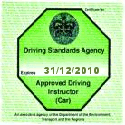|
|
Check for the badge ?? |
|
| |
In the UK,
only Approved Driving Instructors (ADIs), and licenced
instructors under training, can give instruction for
payment. It is illegal for anyone else to charge you for
driving lessons. Two types of badge are issued by the
Driver and Vehicle Standards Agency (DVSA) for display in tuition
vehicles. A
green, octagonal
badge
shows the instructor is fully qualified and approved. A
pink,
triangular badge
shows the instructor is licenced under training and is not
yet fully qualified.
The DVSA monitors the quality of tuition provided by ADIs,
and grades them accordingly.
Learning to drive can be an expensive business, so it makes
sense to choose your driving instructor carefully. Below are
some questions you may wish to consider. Always shop around
and compare at least two or three instructors in your area.
Questions to
Consider
Is the instructor a fully-qualified Approved Driver
Instructor (ADI)? Check for a green, octagonal DSA badge in
the front windscreen of the tuition vehicle.
If a driving school proposes to use a trainee instructor for
part of your training, what percentage of lessons will be
with the trainee and will you pay reduced fees?
What is the instructor's pass rate for learners sitting the
practical test for the first time?
Can you have a free or reduced-price initial lesson to see
how you get on with the instructor?
How long has the instructor been teaching learner drivers?
How long, and how much, are lessons?
Will you get a discount for booking a block of lessons in
advance?
What happens if you need to cancel a pre-arranged lesson?
What model of car is used as the tuition vehicle?
Does the tuition vehicle have dual controls?
How old is the tuition vehicle?
Can the driver's seat and steering column of the tuition
vehicle be adjusted to suit your height and build? This is
particularly important if you are either very tall, or very
short.
Does the tuition vehicle have safety features such as air
bags and side impact protection?
Will the instructor pick you up and drop you off at your
home address, or other location that is convenient to you?
Will the instructor be giving you undivided attention, or
will you be expected to either pick up the next pupil or
drop off the previous one during the time allocated to your
lesson?
Is the instructor recommended by a relative or close friend?
Does the instructor smoke in the tuition vehicle? This could
be important to you if you are a non-smoker.
|
Practising with Friends and Relatives
If you have the opportunity to drive while accompanied by
friends or relatives, this can be an inexpensive way to
increase your experience of driving before sitting your
test.
Remember that any person who sits with you must be at least
21 and have held a full driving licence for at least three
years.
To make best use of these opportunities, ask your driving
instructor what you should practice, and where. Also, get
anyone who accompanies you to read the Official Guide to
Accompanying L-Drivers.
Finally, if driving with a friend or relative, always ensure
that you are insured to drive the car being used.
|
 |
|
